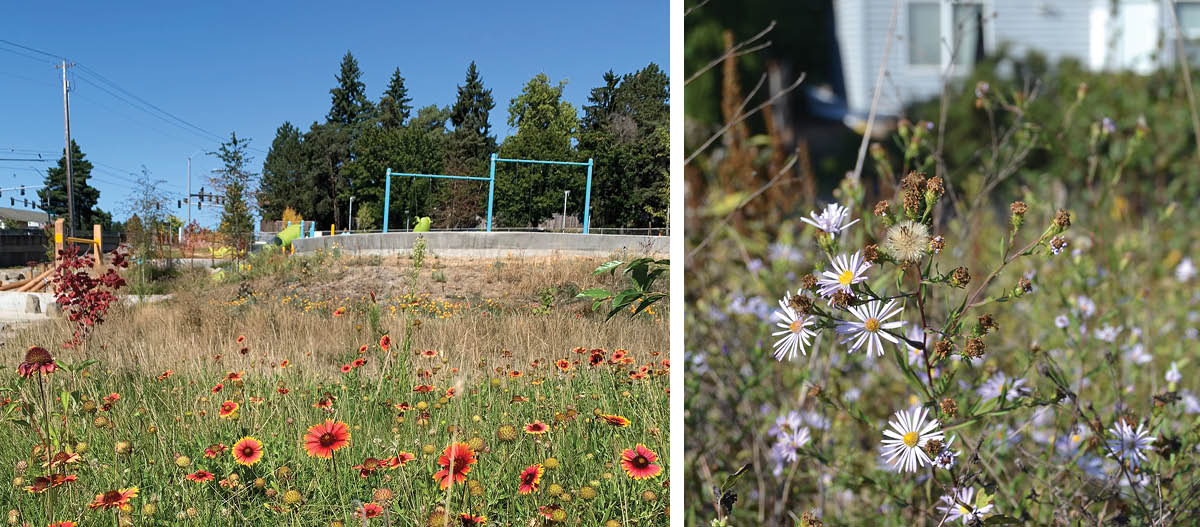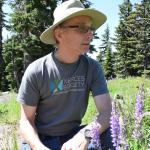While the term “park” often brings to mind a neatly maintained area with vegetation limited to turf, lawn, and trees—the naturalistic landscapes created by park architects of past centuries, for example—parks can be so much more than green places with tidy plants. The inventory of a park department or district may include swim centers, sports fields, playgrounds, and community gardens, but increasingly it includes creeks, wetlands, woodlands, forests, prairie, and other natural areas. Parks departments have become significant natural resource managers, tasked by their communities to care for and take leadership on a multitude of environmental concerns, from waste reduction and recycling to water quality and wildlife.
Reimagine parks as a key to community and pollinator health
Around the nation, the value that nature in parks offers to local residents is being recognized and acted upon. Multipurpose parks provide sports fields and restored creek corridors, support regional greenways and neighborhood trails, and offer spaces for family picnics or friends to gather for coffee. Traditional playgrounds with slides and swing sets are being reimagined as nature play areas where children can explore and get grubby—and gain the emotional benefits from time spent outdoors. Informal recreation in the form of walking, running, biking, birdwatching, and other individual pursuits have become the dominant uses of increasingly varied park facilities. At a fundamental level, parks that provide a healthy environment also support healthy people and healthy communities—and at the heart of a healthy environment are pollinators.
Many species of pollinators can flourish in the seemingly inhospitable environment of towns and cities. Butterflies are easy to spot and their presence in parks is widely noted. Bees, in contrast, are less obvious, but there are many examples of their diversity, even in densely developed neighborhoods. In California, more than 70 species of bees were identified in the gardens of Albany and Berkeley. In Tucson, Arizona, 62 species of bees were found in fragments of desert scrub habitat. In New York City, 54 species of bees were discovered in community gardens in East Harlem and the Bronx, and over 100 species were found in suburban gardens just north of the city. Even rare species like the rusty patched bumble bee can be found in parks and gardens in the Upper Midwest. Clearly, community greenspaces are important for these essential animals.

(Left) The recent remodeling of this park integrated a daylighted creek and a flowering meadow with a rebuilt playground to create an easily accessible are that invites nature exploration. (Right) Nature awaits just over the back fence in this suburban neighborhood. Walking trails connect the community with playgrounds and other recreation options and habitat offers shelter to a diversity of wildlife. (Photo: Matthew Shepherd)
Xerces releases new guide for pollinator-friendly parks
To support the work being done by park managers across the country, the Xerces Society has recently released Pollinator-Friendly Parks: Enhancing Our Communities by Supporting Native Pollinators in Our Parks and Other Public Spaces. This is an updated and greatly expanded version of the 2008 release of Pollinator-Friendly Parks. If you do have a copy of that first edition, you’ll want to replace it with this one!
Pollinator-Friendly Parks is chock full of information to help park managers plan and care for properties with pollinators and other insects in mind. The structure follows the four principles of our Bring Back the Pollinators campaign—grow flowers for nectar and pollen, provide places for nesting and egg laying, avoid pesticide use, and share the word about what you’re doing—with chapters that provide detailed information on how to apply each of the principles to greenspaces. We also included an overview of the opportunities offered by different types of park facilities, and some ways to start thinking about how to address pollinator conservation in your own parks. These are supported by background information on the diversity and natural history of bees and butterflies and the threats they face, as well as appendices offering lists of books, web sites, and other resources so you can explore the topic more deeply. We hope that the guidelines will provide enough information to enable you to plan and take action.
 The need for pollinators may seem more obvious for residents growing food in a community garden, but they are important for the health of all parks. Steps to support pollinators can be taken in any greenspace. (Photo: Matthew Shepherd)
The need for pollinators may seem more obvious for residents growing food in a community garden, but they are important for the health of all parks. Steps to support pollinators can be taken in any greenspace. (Photo: Matthew Shepherd)
Urban conservation plays an increasing role in pollinator health
Studies in North America and the UK have shown that dense urban areas with a variety of flowering plants cultivated or growing spontaneously in gardens, parks, along sidewalks or in yards, can support a diversity of native pollinators. As towns and cities spread rapidly and wild spaces are lost, parks, gardens, and other greenspaces are increasingly important to the vitality of our communities and individual well-being. Pollinator-friendly parks not only support the physical and emotional benefits gained from exercise or growing fresh food in a community garden plot, they are also excellent settings for activities such as nature watching or just quiet contemplation of sitting among flowers and the hum of insect life. By making parks more pollinator friendly, they are also more human friendly.
Further Reading
Download your copy of Pollinator-Friendly Parks: Enhancing Our Communities by Supporting Native Pollinators in Our Parks and Other Public Spaces
Learn about the four principles of how to Bring Back the Pollinators
Find the recommended pollinator-friendly plants for your region
Learn from Xerces experts about Building Pollinator Habitat in Towns and Cities. This series of recorded webinars covers most of the US!





